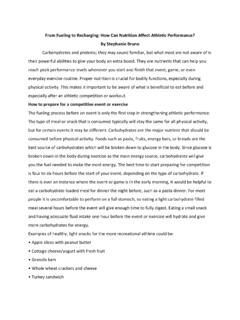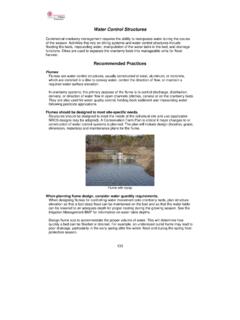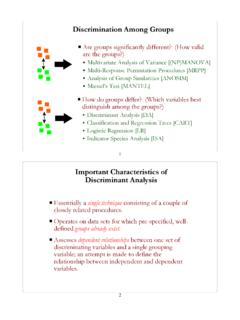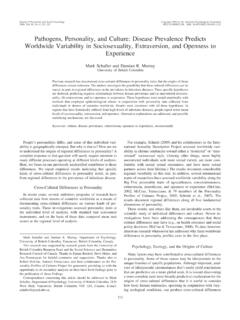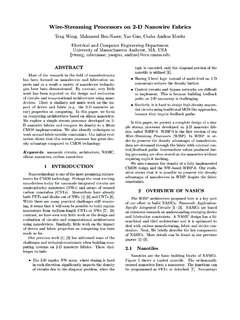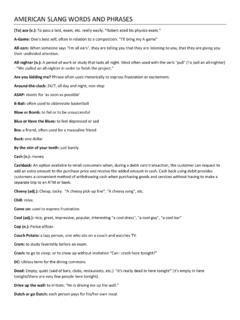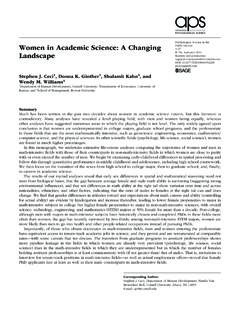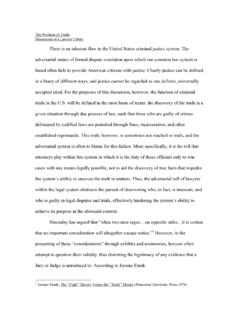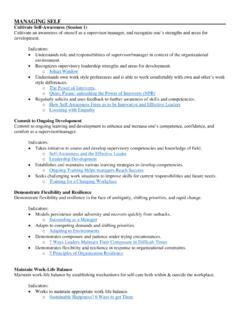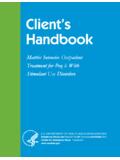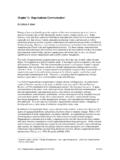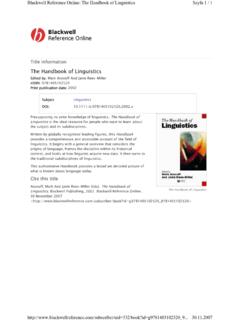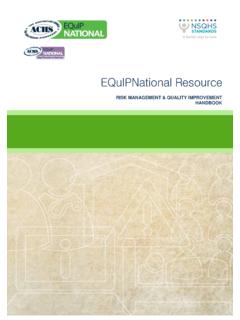Transcription of Teaching and Learning Online - UMass Amherst
1 Teaching and Learning Online communication , Community, and Assessment A handbook for UMass Faculty Editors:My a P o e , Research Associate f or Assessment Mar tha L. A. Stassen Director of Assessment Office of Academic Planning and Assessment Univ ersity of Massachusetts Amherst This handbook is a joint project of the Center for Teaching , Office of Academic Planning and Assessment, the Center for Computer-Based Instructional Technology, and Continuing Education. Publication was supported by a Professional Development Grant in Instructional Technology and Distance Learning from the University of Massachusetts President's Office and the Office of Academic Planning and Assessment.
2 Contributing Authors Senior Online Fellows Robert Feldman, Professor, Psychology ( Amherst ) Donna Zucker, Assistant Professor, School of Nursing ( Amherst ) Online Fellows Keith Carver, Professor, Electrical and Computer Engineering ( Amherst ) Nancy Cohen, Department Head, Nutrition ( Amherst ) Dennis Hanno, Associate Dean for Undergraduate Matters, Isenberg School of Management ( Amherst ) John Jessoe, Director, Distance Leaning and Video Production Center (Boston) David Lewis, Professor, Manufacturing and Management Information Systems (Lowell) John Leong, Professor, Molecular Genetics and Microbiology (Worcester) Brian Miller, Lecturer, Hotel Restaurant & Travel Administration ( Amherst ) Susan Pasquale, Director of Curriculum and Faculty Development in the Department of Medical Education (Worcester) Mark Schlesinger, Professor, communication and Theater Arts (Boston) Tim Shea, Associate Professor Marketing/BIS Development (Dartmouth) Greg Stone, Director of Internet Developing (Dartmouth) Steve Tello, Associate Director of Distance Learning (Lowell) Project Support ( Amherst )
3 Kevin Aiken, Director of Continuing Education Tracy Cantwell, Center for Teaching Vicky Getis, Senior Research Fellow, Computer Science Dave Hart, Executive Director of the Center for Computer-Based Instructional Technology Mya Poe, Research Associate for Assessment, Office of Academic Planning and Assessment Mei-Yau Shih, Coordinator of Teaching Technologies, Center for Teaching Martha L. A. Stassen, Director of Assessment, Office of Academic Planning and Assessment The contributing authors are grateful for the many UMass colleagues who provided their suggestions on earlier versions of this handbook . We d also like to acknowledge the contributions of colleagues at other institutions of higher education whose work is referenced throughout this handbook .
4 Contents Introduction.. 3 Chapter 1: Teaching in Online Learning Environments: Overview. 5 What is Online Learning ? .. 5 Advantages of Learning Online .. 6 Advantages of Teaching Online .. 7 Challenges of Teaching Online .. 8 Common Questions .. 9 Common .. 9 Chapter 2: Teaching an Online Course.. 11 Preparing to Teach Online .. 11 Preparing Students to Learn Online .. 13 Common Questions .. 18 Appendix: Student Guide to Conventions of Online communication . 19 Chapter 3: Teaching and Learning Challenges.. 21 Structuring an Online Course .. 22 23 25 Course Organization .. communication .. Creating Community .. Student-to-Student Interaction.
5 29 30 31 Faculty-to-Student interaction .. Tone.. 28 Pedagogical Focus: Facilitating Discussions .. 33 Chapter 4: Assessing Student Learning .. 35 What is Assessment? .. 35 Evaluating Student Performance for Grading Purposes .. 36 Assessing Whether the Course is Working .. 39 Chapter 5: Resources.. 41 Troubleshooting Student Issues .. 41 Troubleshooting Technological Issues .. 41 Electronic Resources and .. 42 UMass Resources .. 44 Teaching and Learning Online University of Massachusetts 2 Introduction We are very pleased to welcome you to the first edition of Teaching and Learning Online : A handbook for UMass Faculty. Whether you are totally inexperienced in Online instruction or are relatively savvy about it, we think you will find the answers to many questions about how to create and manage a state-of-the-art Online course.
6 This guide was developed by a group of UMass faculty and staff who participated in a year-long Online Fellows program supported by a Professional Development Grant in Instructional Technology from the UMass President s Office. The participants, who represented all UMass campuses and various disciplines, were already currently Teaching Online courses. The Online Fellows Program was developed through the joint efforts of the Center for Teaching , the Office of Academic Planning and Assessment, the Center for Computer-Based Instructional Technology, and Continuing Education. Teaching and Learning Online is designed to guide you through the decisions that you will need to make if you teach Online .
7 It reflects the joint experience and wisdom of the Online Fellows, UMass faculty like yourself who up until a few years ago had no experience in Teaching Online . We have tried to make the guide straightforward and inviting, raising and answering the basic questions that novice Online instructors would be contemplating. Of course, no guide is able to cover every aspect of Online Teaching . There are several areas that we have not addressed, including specific technical issues ( , course management systems), legal issues involving intellectual property, and compensation issues. What we hope we have accomplished, though, is to provide you with a guide to the major pedagogical and assessment issues associated with Teaching an Online course.
8 All of the Online Fellows have found Teaching Online to be a rewarding and invigorating experience, and we hope this guide eases your transition into the world of Online Learning . Donna Zucker Robert S. Feldman Senior Online Fellows Teaching and Learning Online University of Massachusetts 3 Teaching and Learning Online University of Massachusetts 4 1 Teaching in Online Learning Environments: Overview Contents: What is Online Learning ? Advantages of Learning Online Advantages of Teaching Online Challenges of Teaching Online Common Questions Common Terms This chapter outlines some of the advantages and challenges in Teaching and Learning in an Online environment.
9 What is Online Learning ? The term Online Learning (or, as it is sometimes called, distance Learning ) includes a number of computer-assisted instruction methods. For the purposes of this handbook : Online Teaching and Learning is faculty-delivered instruction via the Internet. Online instruction includes real-time (synchronous) and anytime, anywhere (asynchronous) interactions. What is Online Learning ? Two parallel processes take place in an Online environment: 1. Students become more active, reflective learners. 2. Students and teachers engage in Learning through the use of technology and become more familiar with technology by using it. Online Learning is most effective when delivered by teachers experienced in their subject matter.
10 The best way to maintain the connection between Online education and the values of traditional education is through ensuring that Online Learning is delivered by teachers, fully qualified and interested in Teaching Online in a web-based environment (Feenberg 1998). Teaching and Learning Online University of Massachusetts 5 Approaches to Online Learning Two approaches to Online Learning have emerged: synchronous and asynchronous Learning . Synchronous Learning is instruction and collaboration in real time via the Internet. It typically involves tools, such as: live chat audio and video conferencing data and application sharing shared whiteboard virtual "hand raising" joint viewing of multimedia presentations and Online slide shows Asynchronous Learning methods use the time-delayed capabilities of the Internet.

